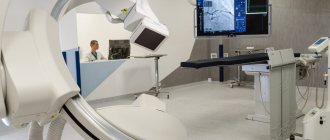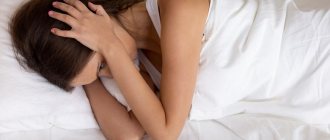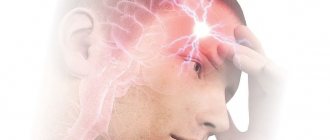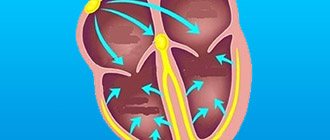There are several ways to deal with panic attacks. All of them can be divided into three types:
- Medicines;
- Psychological (psychotherapeutic) techniques and techniques;
- Other techniques typically used in specialized clinics (physiotherapy, biofeedback therapy, physical therapy, reflexology).
Below we will describe in detail the first group - medications for panic attacks.
.
Like any medicine, drugs for panic attacks must be prescribed by a clinic doctor, who, before prescribing them, clarifies the patient’s condition and determines all indications and contraindications!
All medications that help with panic attacks are divided into two groups:
- Quick aid equipment (“ambulance”). Can be used once. Allows you to prevent or relieve a panic attack.
- Medicines for continuous use (preventive). Taking these pills helps prevent the development of a panic attack.
Causes of vegetative-vascular dystonia
The main causes of vegetative-vascular dystonia include the following.
- Prolonged stress.
- Mental trauma.
- Physical overexertion.
- Bad habits (smoking, drinking alcohol).
- Negative environmental factors.
- Hereditary predisposition.
- Psycho-emotional overload.
- Sudden and significant changes in environmental conditions.
- Mental fatigue.
- Age-related hormonal changes.
- Severe intoxication.
In addition to the listed reasons that have a direct impact on the appearance of vegetative-vascular dystonia, there are a number of factors that themselves cannot cause VSD, but reveal a predisposition to it. The longer and stronger their exposure, the higher the likelihood of pathology occurring.
Violation of the vegetative functions of the body is promoted by:
- smoking;
- frequent and prolonged work at the computer;
- frequent abuse of alcoholic beverages;
- lack of sleep;
- uncontrolled medication use;
- frequent consumption of very spicy foods.
Causes
Doctors believe that the appearance of panic attacks during VSD is provoked not by one, but by several factors at once. Among the reasons are:
- unhealthy sleep;
- constant presence in stressful situations;
- headache;
- fatigue, overstrain;
- the appearance and further development of osteochondrosis in the cervical spine;
- character traits of a person. For example, suspiciousness;
- presence of a diagnosis of PA in relatives;
- unhealthy lifestyle: drinking alcohol, using drugs, smoking.
Treatment of vegetative-vascular dystonia
If treatment is started in a timely manner, the result in most cases will be positive. However, it may take several months. The duration of therapy directly depends on the form of vegetative-vascular dystonia and varies between 4–10 months. It is impossible to prescribe a universal remedy for VSD that will definitely help overcome the pathology.
The main role in the fight against vegetative-vascular dystonia is played by a healthy lifestyle, feasible physical activity and lack of stress. In addition, to achieve results, you need to give up smoking and drinking alcohol, normalize your work and rest schedule, adhere to proper nutrition, diversifying your diet with vegetables, fruits, nuts and dairy products.
What is prescribed for VSD? Treatment of vegetative-vascular dystonia is a whole range of measures, which may include the following:
- diet;
- taking medications;
- physical therapy;
- breathing exercises;
- acupuncture;
- massage;
- balneotherapy;
- phototherapy;
- psychotherapy;
- physiotherapeutic procedures (massage, breathing exercises, etc.).
There are a lot of drugs prescribed for VSD. Their choice depends on the symptoms of the pathology, the person’s health status, age and other factors. Therefore, only a doctor can tell you what to take for VSD. For each patient, the doctor develops an individual treatment regimen (based on the clinical picture), which may include the following groups of drugs:
- soothing herbal remedies;
- antidepressants;
- tranquilizers and anxiolytics;
- nootropics;
- vascular drugs;
- psychotropic drugs;
- adaptogens, etc.
Drug elimination of symptoms of vegetative-vascular dystonia
Symptomatic treatment is aimed at eliminating the manifestations of vegetative-vascular dystonia.
- For rapid heartbeat and periodic surges in blood pressure, beta-blockers are indicated.
- For VSD and panic attacks, taking tranquilizers is indicated.
- Heart pain can be relieved with sedatives. For bradycardia (heart rate less than 50 beats per minute), it is recommended to take a drug that stimulates heart contractions.
- Vasodilators are also necessary for VSD. ACE inhibitors have this effect.
- If pain (in the abdomen, joints, muscles, heart) due to VSD cannot be relieved, doctors may prescribe tricyclic or serotonergic antidepressants. Typically, a short course of taking these drugs quickly relieves pain.
- With the hypertensive type of vegetative-vascular dystonia, agents for the blood vessels of the brain are needed that improve blood circulation. These drugs will relieve dizziness due to VSD caused by high blood pressure.
- If constipation appears against the background of VSD, then you should not only adjust your diet, where fiber-rich foods will predominate, but also, if necessary, take laxatives recommended by your doctor.
- If the patient has a tendency to diarrhea, he, on the contrary, needs to limit the consumption of foods containing fiber and take fixatives as necessary. Also in this case, sorbents can be used.
- To eliminate signs of venous insufficiency, venotonic drugs may be prescribed. In addition, such tablets help with headaches due to VSD and eliminate tinnitus.
- For headaches due to low blood pressure, it is recommended to take tonics.
Thus, along with the treatment of the underlying pathology, a fairly wide range of tablets for VSD are used to eliminate the unpleasant symptoms of vegetative-vascular dystonia.
Quick help for a panic attack
Benzodiazepine tranquilizers
The most effective and fastest-acting medications for panic attacks are a group of benzodiazepine tranquilizers
. These include:
- alprazolam (Xanax),
- clonazepam,
- diazepam (Relanium),
- bromodihydrochlorophenylbenzodiazepine (phenazepam).
These are potent drugs and therefore are not commercially available. They can be purchased using special prescriptions, which can only be prescribed by certified doctors in licensed clinics.
The action of benzodiazepine tranquilizers provides rapid relief of anxiety, vegetative manifestations (rapid pulse and breathing, sweating, trembling, chills and heat waves, dizziness, etc.), normalization of sleep and appetite.
Since the basis of any panic attack is anxiety and excessive activation of brain structures responsible for the protective anxiety reflex, then, regardless of the causes, mechanism of development and manifestation of panic, tranquilizers always have a quick effect. They will either prevent the development of a panic attack, or (if it has already begun) stop it.
Benzodiazepine tranquilizers are used once - as an ambulance, or in short courses (usually no more than a week). With long-term use, dependence is formed, one of the manifestations of which will be “increasing tolerance” - the need to increase the dose to achieve an effect.
These drugs are often used in tablet form. As a rule, taking one tranquilizer tablet ensures the development of a therapeutic effect in 20-40 minutes.
Some of these drugs (diazepam, bromodihydrochlorophenylbenzodiazepine) exist in the form of a solution, which allows them to be used as injections intramuscularly or intravenously, in which case the effect occurs very quickly - from a few seconds to several minutes.
Advantages of benzodiazepine tranquilizers: pronounced anti-anxiety effect, rapid onset of action, well tolerated.
Disadvantages: difficult to purchase (you need a doctor's prescription, a special prescription form), a common side effect is drowsiness and lethargy; if taken regularly, they can cause physical and mental dependence.
Non-benzodiazepine tranquilizers
The next group is non-benzodiazepine tranquilizers
. They are distinguished from the first group by a different chemical structure. The most common representatives:
- hydroxyzine (atarax),
- mebicar,
- etifoxine,
- meprobamate.
In terms of potency, they are inferior to the drugs of the previous group. But they also have their advantages: they are well tolerated, do not cause drowsiness, do not develop dependence, and are easier to purchase in pharmacies (no special prescriptions are needed).
The most common remedy in this group is ATARAX
. They can be used once to prevent or relieve a panic attack. It is also used for long-term use, which can prevent the recurrence of a panic attack.
Thus, tranquilizers
- the most common and popular group of pills for panic attacks. It has been noticed that many people who have long gotten rid of panic attacks, but remember these unpleasant anxiety states, try to carry a tranquilizer pill with them “just in case.”
Neuroleptics
Neuroleptics with sedative action. This is the next group of drugs that have a sedative effect and can relieve a panic attack. The most common tablets are:
- Thioridazine (Sonapax);
- Periciazine (neuleptil);
- Chlorprothixene (Truxal);
- Quetiapine (Seroquel);
- Alimemazine (teraligen);
- Sulpiride (eglonil).
The general sedative effect of these drugs allows, when taken continuously, to prevent the development of panic attacks, and when taken once, to relieve a panic attack.
The disadvantage of this group of drugs is that, in addition to anxiety, other emotional reactions (joy, surprise, delight, pleasure, curiosity, melancholy, etc.) can be suppressed.
Antidepressants with sedative effects
Despite the fact that antidepressants are the most prescribed pills in the complex treatment of panic attacks, they can also be used as an “ambulance” - once to stop a panic attack. For this purpose the following are most often used:
- Amitriptyline;
- Clomipramine (Anafranil);
- Mianserin (lerivon)
Unlike antipsychotics and tranquilizers, the effect of antidepressants does not develop as quickly, but is longer lasting.
Other drugs for quick relief of an attack
- aminophenylbutyric acid (phenibut),
- glycine,
- ethyl alcohol (alcohol),
- valocordin or corvalol (and their analogues),
- beta-blockers (anaprilin, atenolol),
- alpha-blockers (clinidine), etc.
Eltacin® in the treatment of VSD
Therapy for VSD should be aimed at eliminating its cause, and not masking the symptoms. This is precisely why Eltacin® was developed. It contains 3 amino acids: cystine, glycine and glutamic acid. Their combination promotes the production of glutathione in the body - one of the powerful and natural antioxidants in the body, which neutralizes the effects of free radicals, prolongs the life of cells and prevents their death, normalizes the supply of oxygen to tissues and individual cells and helps enzymes maintain their functions. Thanks to this, the drug allows you to eliminate the symptoms of VSD, as well as influence the root of the problem and restore the balance between organs and systems, disturbed by the negative effects of free radicals.
Eltacin®:
- is the strongest endogenous antioxidant;
- sold at an affordable price.
- dispensed without a doctor's prescription;
In what situations will Eltacin® be useful to you?
The main indications for use of the drug are autonomic dysfunction. Eltacin® is also recommended for increased physical activity to avoid complications for the cardiovascular system, including for professional athletes, as well as for heart failure as part of complex treatment.
The quality of life of people with chronic heart failure is determined by how rationally they can distribute their own physical resources. Eltacin® improves the contractility of the myocardium and reduces its need for oxygen, so even with ineffective blood circulation, heart cells do not suffer from a lack of energy. Regular use of Eltacin® prolongs active life in chronic heart failure, reduces the severity of symptoms, and in acute heart failure improves the prognosis and helps to recover faster. Used as a cardioprotector.
If you decide to lose weight in the gym or go jogging, but are not confident in your physical endurance, start a course of Eltacin® 2 weeks before training. This will protect your heart from unnecessary stress and prevent all possible complications that you risk getting before you begin to get into the desired shape.









